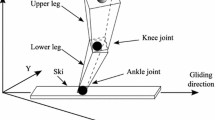Abstract
This paper develops a 2-dimensional model to simulate skiing movements based on multibody system. The model includes one rigid ski and five rigid skier’s segments (arms, trunk, thighs, shanks, and boots). The ski is modeled as a discrete-point rigid body. A spring-damper element is used to describe the interaction of every point between the ski and snow. The snow ground can be planar or uneven terrains. The air resistance of skier and ski are considered. Finally, several simple skiing movements were simulated. On the one hand, these simulations included some general skiing characteristics such as downhill, rotation, flying, and landing. On the other hand, the snow surfaces could be planar slope, sinusoidal slope, and rampant slope. The results show that the model can simulate simple types of skiing, and can provide kinematic and kinetic data such as the skier’s displacement, velocity, acceleration, joint moment and force, and ground reaction force. The model may be useful for building 3-dimensional skiing model, and for further studies of skiing movements.
Similar content being viewed by others
References
Schiehlen, W., Guse, N., Seifried, R.: Multibody dynamics in computational mechanics and engineering applications. Comput. Methods Appl. Mech. Eng. 195, 5509–5522 (2006)
Pandy, M.G.: Computer modeling and simulation of human movement. Ann. Rev. Biomed. Eng. 3, 245–273 (2001)
Hodgins, J.K., Wooten, W.L.: Animating human athletes. In: Robotics Research: The Eighth International Symposium, pp. 356–367. Springer, Berlin (1998)
Imaizumi, H., Fujioka, T., Omae, M.: Rider model by use of multibody dynamics analysis. JSAE Rev. 171, 75–77 (1996)
Blajer, W., Czaplicki, A.: Modeling and inverse simulation of somersaults on the trampoline. J. Biomech. 34, 1619–1629 (2001)
Spägele, T., Kistner, A., Gollhofer, A.: Modelling, simulation and optimisation of a human vertical jump. J. Biomech. 32, 521–530 (1999)
Morawski, J.M.: Control system approach to a ski-turn analysis. J. Biomech. 6, 267–279 (1973)
Kawai, S., Kato, K., Sakata, T.: Effects of ski model on ski turn. Trans. Jpn. Soc. Mech. Eng. 68, 2301–2307 (2002)
Kawai, S., Otani, H., Sakata, T.: Coupled motion of ski and elastic foundation under ski control. JSME Int. J. Ser. C 46, 614–621 (2003)
Lieu, D.K., Mote, C.D.: Mechanics of the turning snow ski. In: Skiing Trauma and Safety: Fifth International Symposium, ASTM STP 860, pp. 117–140. American Society for Testing and Materials, Philadelphia (1985)
Hirano, Y., Tada, N.: Mechanics of a turning snow ski. Int. J. Mech. Sci. 36, 421–429 (1994)
Hirano, Y., Tada, N.: Numerical simulation of a turning alpine ski during recreational skiing. Med. Sci. Sports Exerc. 28, 1209–1213 (1996)
Gerritsen, K.G.M., Nachbauer, W., Van den Bogert, A.J.: Computer simulation of landing movement in downhill skiing: anterior cruciate ligament injuries. J. Biomech. 29, 845–854 (1996)
Nordt, A.A., Springer, G.S., Kollár, L.P.: Simulation of a turn on alpine skis. Sports Eng. 2, 181–199 (1999)
Bruck, F., Lugner, P., Schrestter, H.: A dynamic model for the performance of carving skis. Ski. Trauma Saf. 14, 10–23 (2003)
Zatsiorsky, V.M., Selujanov, V.N.: The mass and inertia characteristics of the main segments of the human body. Biomechanics VIII-B, 1152–1159 (1983)
Casolo, F., Lorenzi, V., Vallatta, A., Zappa, B.: Simulation techniques applied to skiing mechanics. In: Science and Skiing, pp. 116–130 (1997)
García de Jalón, J., Bayo, E.: Kinematic and Dynamic Simulation of Multibody Systems—The Real-Time Challenge. Springer, Berlin (1994)
Hao, Q.W., Men, C.S., Tong, Y.D., Ge, B.Z.: Kinematic study on bLFF movement of freestyle aerial in pool training by Ji Xiao-ou. J. Shenyang Inst. Phys. Educ. 22, 18–33 (2003)
Author information
Authors and Affiliations
Corresponding author
Rights and permissions
About this article
Cite this article
Chen, L., Qi, ZH. A 2-dimensional multi rigid bodies skiing model. Multibody Syst Dyn 21, 91–98 (2009). https://doi.org/10.1007/s11044-008-9129-z
Received:
Accepted:
Published:
Issue Date:
DOI: https://doi.org/10.1007/s11044-008-9129-z




